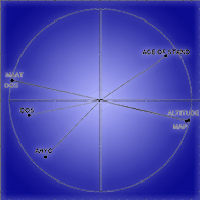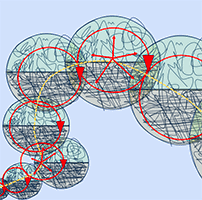
Soil CO2 efflux in uneven-aged and even-aged Norway spruce stands in southern Finland
Atte Kumpu (1) , Annikki Mäkelä (1), Jukka Pumpanen (2), Jussi Saarinen (1), Frank Berninger (1)
iForest - Biogeosciences and Forestry, Volume 11, Issue 6, Pages 705-712 (2018)
doi: https://doi.org/10.3832/ifor2658-011
Published: Nov 06, 2018 - Copyright © 2018 SISEF
Research Articles
Abstract
Even-aged forests usually act as carbon sinks during most of their rotation. However, after clearcut they become sources of carbon for a period of several years. Applying uneven-aged forest management with selective cuttings will maintain tree cover and reduce the environmental impact on forest floor. The aim of this study was to compare the soil CO2 efflux between uneven-aged and even-aged Norway spruce stands with similar site properties, to investigate the effect of management practices on soil CO2 efflux and its possible correlation with soil environmental and chemical properties. We measured soil CO2 efflux in even- and uneven-aged Norway spruce stands (Picea abies [L.] Karst) in southern Finland during the summer of 2013 using closed chamber method on fixed measuring points. The study included two uneven-aged stands and two even-aged stands (a clearcut site and a mature even-aged stand). Soil moisture and soil temperature were measured at the same time as soil CO2 efflux. Soil cores were collected from the topsoil of each study plot to determine soil carbon and nitrogen concentrations. Mean soil CO2 efflux through the summer was highest in the clearcut plot (0.367 mg m-2 s-1) followed by the uneven-aged stands (0.298 and 0.257 mg m-2 s-1, respectively) and the smallest fluxes were measured in the mature even-aged stand (0.224 mg m-2 s-1). There was no statistically significant difference in soil CO2 efflux between the even- and uneven-aged stands of the same site fertility. Even- and uneven-aged stands did not differ significantly in soil moisture or soil temperature. Soil CO2 efflux increased steadily with soil temperature, whereas increasing soil moisture considerably increased soil CO2 efflux at lower moisture levels but only moderately at higher soil moisture levels. Soil carbon and nitrogen concentration did not differ between the study plots of the same fertility. Uneven-aged structure forestry did not prevent the increase in soil CO2 efflux after cuttings. However, the large variation in soil CO2 efflux rates within the uneven-aged stands suggests that the stand level CO2 efflux can be controlled with the intensity of the cutting.
Keywords
Uneven-aged Forest Structure, Even-aged Forest Structure, Soil CO2 Efflux, Norway spruce
Authors’ Info
Authors’ address
Annikki Mäkelä
Jussi Saarinen
Frank Berninger
University of Helsinki, Department of Forest Sciences, P.O. Box 27 (Latokartanonkaari 7) FI-00014 Helsinki (Finland)
University of Eastern Finland, Department of Environmental and Biological Sciences, P.O. Box 1627, FI-70211 Kuopio (Finland)
Corresponding author
Paper Info
Citation
Kumpu A, Mäkelä A, Pumpanen J, Saarinen J, Berninger F (2018). Soil CO2 efflux in uneven-aged and even-aged Norway spruce stands in southern Finland. iForest 11: 705-712. - doi: 10.3832/ifor2658-011
Academic Editor
Ana Rey
Paper history
Received: Oct 20, 2017
Accepted: Sep 18, 2018
First online: Nov 06, 2018
Publication Date: Dec 31, 2018
Publication Time: 1.63 months
Copyright Information
© SISEF - The Italian Society of Silviculture and Forest Ecology 2018
Open Access
This article is distributed under the terms of the Creative Commons Attribution-Non Commercial 4.0 International (https://creativecommons.org/licenses/by-nc/4.0/), which permits unrestricted use, distribution, and reproduction in any medium, provided you give appropriate credit to the original author(s) and the source, provide a link to the Creative Commons license, and indicate if changes were made.
Web Metrics
Breakdown by View Type
Article Usage
Total Article Views: 46644
(from publication date up to now)
Breakdown by View Type
HTML Page Views: 39188
Abstract Page Views: 3377
PDF Downloads: 3239
Citation/Reference Downloads: 6
XML Downloads: 834
Web Metrics
Days since publication: 2601
Overall contacts: 46644
Avg. contacts per week: 125.53
Citation Metrics
Article Citations
Article citations are based on data periodically collected from the Clarivate Web of Science web site
(last update: Mar 2025)
Total number of cites (since 2018): 4
Average cites per year: 0.50
Publication Metrics
by Dimensions ©
Articles citing this article
List of the papers citing this article based on CrossRef Cited-by.
References
Metsätyypit ja niiden merkitys [Forest types and their signifigance]. Acta Forestalia Fennica 56 (4): 1-71. [in Finnish]
Gscholar
The decree for sustainable management and use of forests (1308/2013). Forest law no. 1308/1996, issued on 30 Dec 2013, Helsinky, Finland.
Gscholar
Metsätyypit: opas kasvupaikkojen luokitteluun [Forest types: a guide for site type classification]. Metsäkustannus, Helsinki, Finland, pp. 182. [in Finnish]
Gscholar
Temperature sensitivity of soil organic matter decomposition in boreal soils. PhD thesis, the Department of Forest Sciences, the University of Helsinki, Helsinki, Finland, pp. 59.
Gscholar
Latent heat exchange in the boreal and arctic biomes. Global Change Biology 20: 3439-3456.
CrossRef | Gscholar
The CO2 dependence of photosynthesis, plant growth responses to elevated CO2 concentrations and their interaction with soil nutrient status. II. Temperate and boreal forest productivity and the combined effects of increasing CO2 concentrations and increased nitrogen deposition at a global scale. Functional Ecology 13: 439-459.
CrossRef | Gscholar
Metsän jatkuva kasvatus. [Continuous cover forestry]. Joen Forest Program Consulting, Joensuu, Finland, pp. 229. [in Finnish]
Gscholar
CO2 efflux from boreal forest soil before and after clear-cutting and site preparation. PhD thesis, Department of Forest Ecology, University of Helsinki, Helsinki, Finland, pp. 51.
Gscholar
Optimal choice between even- and uneven-aged forest management systems. Working Papers of the Finnish Forest Research Institute, Helsinki, pp. 35.
Gscholar
Maaperätekijät [Soil factors]. In: “Ympäristömuutos ja metsien kunto: metsien terveydentilan tutkimusohjelman loppuraportti” [Environmental change and forest health: final report for the research program for forest health] (Mälkönen E ed). Metsäntutkimuslaitos, Vantaa, Finland, pp. 65-74. [in Finnish]
Gscholar

















